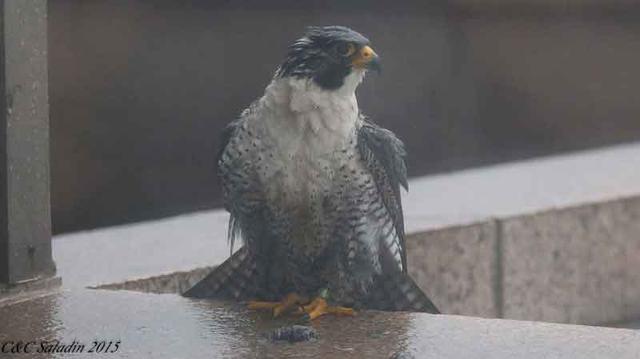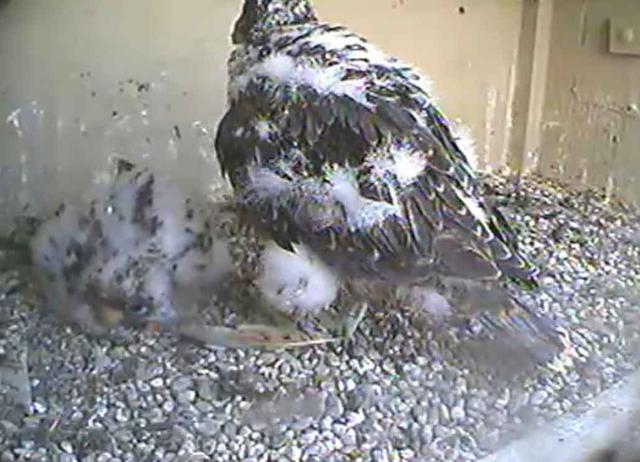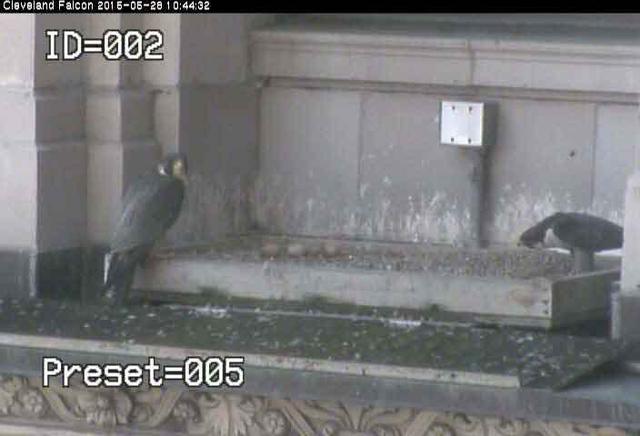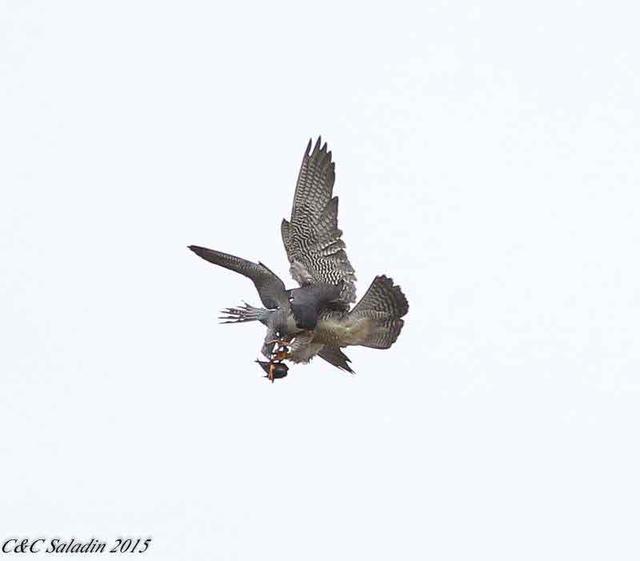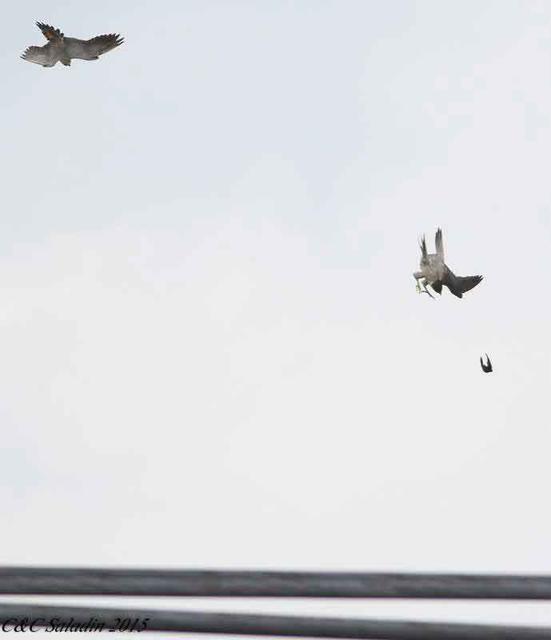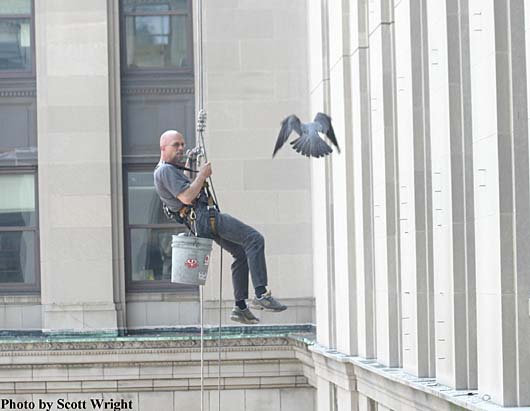FALCON FLASH
Dateline: Cleveland, Ohio
June 1, 2015
Click here to read what happened earlier
Yes, it is the male with the prey. He dropped it for the female, but on the first try, she didn’t catch it. They immediately both dove to catch it.
Falcon Fans are sad about the death of Newton and Boomer’s one chick. It is hard to understand nature’s way. It is hard for humans to understand why - when the chick toppled outside the safety of the nestbox - didn’t the parents just pick it up and put it back in the nestbox? Maybe they are unable, or maybe they are not programmed by instinct to do so. If one of their young is weak, or perhaps has made a bad decision that put it in a bad spot, the parents leave it alone to either survive or perish. Mr. Harvey Webster, Director
of Wildlife Resources at the Cleveland Museum of Natural History simply says, “These birds know what they are doing.” Another example of the parents leaving a chick to fend for itself is at hatch time. It is very hard work for a chick to break out of its shell and the parents could help it along, but they do not, and some
chicks are not strong enough to hatch. Humans find this hard to understand, because we do everything in our power to help weak and sick people, but for wild creatures, the strength of the species is all important. It is called Survival of the Fittest.
Falcon fans are asking what could be done to prevent a future accident? After all, the nestbox was built by humans when some peregrines decided to move to cities from their traditional nestsites on cliffs. On a cliff nest, parents scrape an indentation in the rocks to create a safe spot for their eggs, but before there were nestboxes in cities, eggs would often roll off the buildings’ ledges. To simulate a cliff nest, humans began to build simple boxes with gravel and placed them on building ledges. This solved the problem of eggs rolling off.
Mr. Webster says, “What can we do going forward? We will reach out to our partners and explore a remodel of the nest tray, enlarging it to the side walls and eliminating the drawbridge feature. The drawbridge was installed years ago to prevent eyases from falling off the ledge on banding day. If banding is no longer a priority at this site, the drawbridge is not needed”.
The good news is that the species has recovered from near extinction and there are many healthy chicks growing and flourishing. At our new study nestsite at the Cleveland Clinic, it was raining hard when Mr. and Mrs. Saladin visited. Here is the dad, Dipper.
Peregrine falcon couples bond throughout the nesting cycle by hunting together and by exchanging food in the air. This behavior strengthens their bond. Peregrine falcons display unbelievable flying skills as they maneuver in intricate flying patterns. The following pictures show an aerial food exchange. Can you
tell which is the male and which is the female?
Mr. and Mrs. S continue, “Now at approximately 25 days they are really starting to show their increased mobility (walking fully on their feet) and alertness to movement, as well as spending much of their time preening and shedding their down to reveal more of the juvenile plumage underneath. They are also demonstrating the characteristic interaction/socialization, cocking their heads with curiosity in response to one another's movements, imitating each other as they preen and stretch, and nibbling at one another”.
Here are 3 videos:
2 chicks nibbling at one another: https://youtu.be/rZTUMu9eg74
Chicks preening/stretching/dad coming with food: https://youtu.be/k03ozfQi0ek
Dipper wet, blowing in wind on nestbox: https://youtu.be/IWLMZdMTZDM
Meanwhile, back at the Terminal Tower nestsite, despite the loss of their chick, Newton and Boomer spend time together and you can see them bonding at the nestbox. They have given up on the old eggs, but they are displaying courtship behavior and there is a small chance they might have another clutch of eggs.
Mr. and Mrs. Saladin report, “Dipper and Ely were soaked on the nest ledge as the three chicks were mostly dry inside the box”. The windows were too wet to get pictures of the chicks who are now over 3 weeks old, but here is a picture of chicks that age at another Ohio nest.
Newton and Boomer and Dipper and Ely are 2 peregrine falcon couples
that have successfully raised many strong chicks to add to this strong and
magnificent species. In just a few weeks, Dipper and Ely’s 3 chicks will learn to fly.
Stay tuned for falcon news.
Photos of a falcon attacking a window washer and lethal talons are courtesy of former nest monitor, Mr. Scott Wright. Other photos and video are courtesy of volunteer peregrine nest monitors, Mr. and Mrs. Saladin.
You can see the difference in feather development between the eyasses. The down is flying everywhere as it is replaced by real feathers.
Then the pair came together to catch the falling prey …..
But she couldn’t quite catch the prey and it dropped again ……
This time, the male flew away and allowed the female to catch the falling prey by herself. A moment after this picture was taken, she caught the prey.
Dipper and Ely recently put their flying skills to use. Mr. and Mrs. Saladin got a call from the police telling them that a turkey vulture had dared to come too close to their nest and the pair drove it away.
A turkey vulture is a very large bird with a wingspan of up to 6 feet while a peregrine is about the size of a crow.
Over the years, former nest monitor at this site, Mr. Scott Wright, reports that peregrines have chased off interlopers much larger than themselves who dared to cross the Falcon No Fly Zone. Mr. Wright remembers, “The first male falcon at this nestsite, Szell, actually flew out and tried to attack a Goodyear blimp one year, flying out quite close and vocalizing the entire time until a representative of the Ohio Division of Wildlife called the Federal Aviation Authority - then the blimp never came close again!” Many times, city falcons have dive-bombed humans who came too close, including window washers. Remember, they are 12 stories up!
Beware of the lethal talons!
Click here to read what happened next

